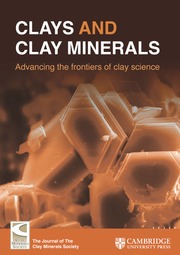Article contents
Selective Sorption and Fixation of Cations by Clay Minerals: A Review
Published online by Cambridge University Press: 01 July 2024
Abstract
Investigations concerning selective sorption and fixation of K and similar cations by clay minerals and soil clays and the mechanisms of these reactions are reviewed. In particular, recent observations on selective sorption of these ions in dilute solutions by weathered micas and vermiculite in relation to the interlayer structures are discussed in detail. Also, implications of the resistance to weathering of small mica particles to cation selectivity by soils are described. Despite the increased understanding of sorption and fixation reactions, the following aspects remain unclear.
First, the mechanism of the collapse of alternate layers in vermiculite on K or Cs sorption has not been unequivocally established. Second, factors that impart stability to the central core of mica particles so that K extraction becomes progressively difficult are not known. Third, inability of Ca or Mg ions to expand interlayers of Cs-saturated vermiculite in contrast to K-saturated vermiculite is not completely understood.
Résumé
On passe en revue les recherches concernant la sorption sélective et la fixation de K et de cations similaires par les minéraux argileux et les argiles des sols ainsi que les recherches concernant les mécanismes de ces réactions. En particulier, des observations récentes sur la sorption sélective de ces ions en solutions diluées par les micas altéres et la vermiculite, en liaison avec les structures interfeuillets, sont discutées en détail. De même, on décrit les implications de la résistance à l’altération de petites particules de mica dans la sélectivité des sols pour le cation. En dépit d’une amélioration dans la compréhension des réactions de sorption et de fixation, les points suivants sont toujours mal éclaircis.
En premier lieu, le mécanisme de la fermeture de couches alternées dans la vermiculite lors de la sorption de K ou Cs n’a pas été établi sans équivoque. En second lieu, les facteurs qui confèrent la stabilité au noyau central des particules de mica, si bien que l’extraction de K devient de plus en plus difficile, ne sont pas connus. En troisième lieu, l’inaptitude des ions Ca ou Mg à ouvrir les espaces interfeuillets de vermiculite saturée par le Cs, ce qui contraste avec le comportement de la vermiculite saturée par le K, n’est pas complètement comprise.
Kurzreferat
Es werden Untersuchungen über die selektive Sorption und Fixierung von K und ähnlichen Kationen durch Tonminerale und Bodentone sowie die Mechanismen dieser Reaktionen überprüft. Insbesonders werden neuere Beobachtungen über selektive Sorption dieser Ionen in verdünnten Lösungen durch verwitterte Glimmer und Vermiculite in bezug auf die Zwischenschichtgefüge im Einzelnen erörtert. Ferner wird die Bedeutung des Widerstandes gegen Verwitterung kleiner Glimmerteilchen für die Kationenselektivität der Böden beschrieben. Ungeachtet des besseren Verständnisses der Sorptions-und Fixierungsreaktionen, sind die folgenden Aspekte weiter unklar.
Erstens ist der Mechanismus des Zusammenbruchs alternierender Schichten im Vermiculit bei K oder Cs Sorption nicht eindeutig festgelegt worden. Zweitens sind die Faktoren, die dem inneren Kern von Glimmerteilchen Stabilität verleihen, so dass die K-Extraktion fortschreitend schwieriger wird nicht bekannt. Drittens ist die Unfähigkeit von Ca oder Mg Ionen die Zwischenschichten von Cs-gesättigtem Vermiculit im Gegensatz zum K-gesättigten Vermiculit auszuweiten nicht ganz verständlich.
Резюме
Дан обзор исследований, посвященных селективному поглощению и фиксации К и аналогичных катионов глинистыми минералами и почвенными глинами, а также механизму подобных реакций. В частности, детально рассматриваются недавно проведенные исследования по селективному поглощению этих катионов в разбавленных растворах выветрелыми слюдами и вермикулитом с разной структурой межслоевого пространства. Стойкость к выветриванию небольших частиц слюды объясняется селективностью почв по отношению к катионам. Однако отмечается, что несмотря на все углубляющееся понимание механизма поглощения и фиксации остаются неясными следующие аспекты.
Во-первых, однозначно не установлен механизм сжатия чередующихся слоев в вермикулите в результате поглощения К или Ca. Во-вторых, до сих пор не выяснены факторы, определяющие устойчивость центральных частей глинистых частиц, благодаря которым удаление К становится все более и более затруднительным. В-третьих, полностью не понята неспособность ионов Ca или Mg вызывать разбухание межслоевых промежутков Cs-насыщенных вермикулитов в противоположность их действию на K-насыщенные вермикулиты.
Information
- Type
- Research Article
- Information
- Copyright
- Copyright © 1972, The Clay Minerals Society
References
- 601
- Cited by

